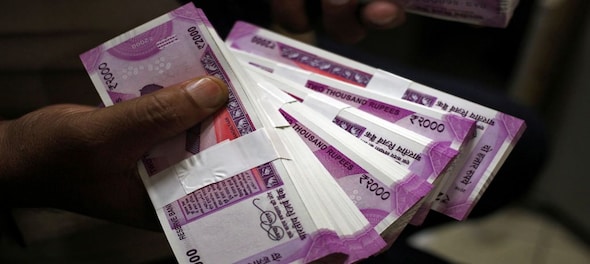
Normally one wouldn’t connect RBI’s dividend to the goings-on in the FX market. But in a series of 5 papers written for the Observatory group over the past 2 months, Prof Ananth Narayan explains how many actions of the RBI in the FX market determine RBI’s dividend. Indeed, he was the only one to correctly estimate that RBI’s dividend in FY22 will be one trillion rupees. The following is an effort, based on Narayan's work, to understand the connection between RBI’s FX operations and its dividend to the government.
The first ground rule to note while calculating the RBI dividend is the rules put in Aug 2019 by the Jalan committee, which require RBI to keep retained earnings at 5.5% of assets and maintain total economic capital (ie retained earnings plus reserves) of 20.8% of assets. RBI’s assets include foreign currencies, gold and govt bonds.
In his March 2021 note, Prof Narayan pointed to several ways the exchange rate impacts dividend:
1. Firstly, if the value of the dollar fell from say 73 to say 71.50, RBI’s FX assets would shrink and so it would have to keep less retained earnings and hence can declare a larger dividend. However, Narayan pointed out that such a fall to 71.50 would only help RBI give an additional 5200 cr rupees as dividend.
2. Secondly, a cheaper dollar will also reduce RBI’s currency revaluation reserves, and as just pointed out, retained earnings plus reserves have to be 20.8% of assets. Narayan calculated that if dollar fell below 71.50 rupees, RBI could struggle to meet this 20.8% economic capital requirement.
3. Third and most important, FX sales by RBI impact the dividend because of the changed accounting rules brought endorsed by the Jalan committee. Before 2019, RBI would revalue all its reserves at the extant exchange rate and transfer the gain/loss to the revaluation reserve. Dividend was not paid out of such reserves. Since 2019, when RBI sells dollars, it considers the historical average price at which it had acquired dollars as the purchase price, deduct that from the price at which it sold dollars in the current year and recognise the difference as realized profits.
Based on RBI’s FY20 annual report, in March, Prof Narayan estimated that “every 10 bn of foreign currency sales by RBI against the rupee” at March levels, might allow RBI “ to recognise up to an additional Rs 170 billion of income to pay out as dividend”.
Narayan concluded that piece with a prescient observation: “we cannot rule out the possibility that the RBI may be more willing to offer USD (meaning sell dollars) in the market – till the end of March” so as to pay a higher dividend.
The RBI released its January and February currency intervention data in late April and its March dollar sales data in its monthly bulletin issued in mid-May. Lo and behold, the table clearly showed that RBI’s gross dollar sales in January, February and March were much larger than in previous months and years confirming Narayan’s argument. Here’s the table which Narayan quoted in his Observatory papers of April 28 and May 18.

As can be seen gross sales in the 9 months of FY21 were $85 billion against only $29 billion in the 12 months of FY20. Prof Narayan concluded that going by these large gross dollar sales, “RBI could likely manage a higher-than-expected dividend of around one trillion rupees to the government on the back of recognition of foreign exchange revaluation gains”. And bingo! The RBI announced a dividend of Rs 99,122 cr.
There is another point Narayan alerts us to, in terms of the connection between RBI dividend and FX markets. In his May 21 Observatory paper he writes: “if the aim is to limit balance sheet expansion and hence limit the need for retaining RBI capital/ reserves, RBI might prefer purchasing foreign currency in forward rather than spot markets”. And indeed RBI’s forward dollar purchases in the current year have been at record highs pushing up the one year forward implied Rupee interest rate close to 5.8 percent, versus one-year t-bills which trade at 3.7 percent.
To conclude there are 4 ways in which events in the currency market impact RBI's dividend to govt
1. An appreciating rupee means a smaller balance sheet hence less need to keep reserves, hence more dividend up to a point. However, beyond a point, a stronger Rupee reduces foreign currency revaluation reserves, and hence constrains dividend payable.
2. On the flip side, a weaker INR increases currency revaluation reserves, which can be converted into realized profits by gross sale of USD in the spot market. All else being equal, after retaining 20.8% of such realized profits to meet Bimal Jalan committee reserve requirements, the rest can be paid out as dividend.
3. Standalone, higher gross spot sale of dollars by RBI helps it recognise revaluation profits from its weighted average holding rate, and hence pay a higher dividend subject to maintaining minimum retained earnings and reserves
4. If dollars have to be purchased, RBI might prefer forward purchases so that balance sheet doesn’t expand, requiring more reserves.
Of course, one wishes that at least prospectively, RBI should categorically convince market players that cynical considerations of enhancing dividend payable to the government will play no part in influencing its financial market intervention.
(Edited by : Jerome)
Check out our in-depth Market Coverage, Business News & get real-time Stock Market Updates on CNBC-TV18. Also, Watch our channels CNBC-TV18, CNBC Awaaz and CNBC Bajar Live on-the-go!


BJP is planning to ban RSS, says Shiv Sena (UBT) chief Uddhav Thackeray
May 18, 2024 8:01 PM
Punjab Lok Sabha elections: Complete list of Congress candidates
May 18, 2024 4:08 PM
Punjab Lok Sabha elections: Check full list of AAP candidates and constituencies
May 18, 2024 12:59 PM
PM Modi, Rahul Gandhi election rallies in Delhi today: Here are the routes to avoid
May 18, 2024 11:28 AM

